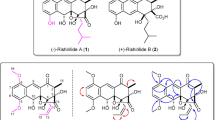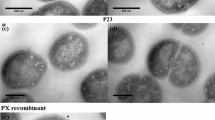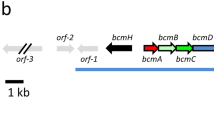Abstract
Medically useful semisynthetic cephalosporins are made from 7-aminodeacetoxycephalosporanic acid (7-ADCA) or 7-aminocephalosporanic acid (7-ACA). Here we describe a new industrially amenable bioprocess for the production of the important intermediate 7-ADCA that can replace the expensive and environmentally unfriendly chemical method classically used. The method is based on the disruption and one-step replacement of the cefEF gene, encoding the bifunctional expandase/hydroxylase activity, of an actual industrial cephalosporin C production strain of Acremonium chrysogenum. Subsequent cloning and expression of the cefE gene from Streptomyces clavuligerus in A. chrysogenum yield recombinant strains producing high titers of deacetoxycephalosporin C (DAOC). Production level of DAOC is nearly equivalent (75–80%) to the total β-lactams biosynthesized by the parental overproducing strain. DAOC deacylation is carried out by two final enzymatic bioconversions catalyzed by D-amino acid oxidase (DAO) and glutaryl acylase (GLA) yielding 7-ADCA. In contrast to the data reported for recombinant strains of Penicillium chrysogenum expressing ring expansion activity, no detectable contamination with other cephalosporin intermediates occurred.
This is a preview of subscription content, access via your institution
Access options
Subscribe to this journal
Receive 12 print issues and online access
$209.00 per year
only $17.42 per issue
Buy this article
- Purchase on Springer Link
- Instant access to full article PDF
Prices may be subject to local taxes which are calculated during checkout






Similar content being viewed by others
References
Hersbach, G.J.M., Van der Beek, C.P. & Van Dijck, P.W.M. The penicillins: Properties, biosynthesis and fermentation. In Biotechnology of industrial antibiotics. (ed. Vandamme, E.J.) 45–140 (Marcel Dekker, Inc., New York; 1984).
Samson, S.M. et al. Cloning and expression of the fungal expandase\hydroxylase gene involved in cephalosporin biosynthesis. Bio/Technology 5, 1207–1214 (1987).
Cantwell, C.A., Beckmann, R., Whiteman, P., Queener, S.W. & Abraham, E.P. Isolation of deacetoxycephalosporin C from fermentation broths of Penicillium chrysogenum transformants: construction of a new fungal biosynthetic pathway. Proc. R. Soc. London B 248, 283–289 (1992).
Beckman, R., Cantwell, C.A., Whiteman, P., Queener, S.W. & Abraham, E.P. Production of deacetoxycephalosporin C by transformants of Penicillium chrysogenum: Antibiotic biosynthetic pathway engineering. In Industrial microorganisms: basic and applied molecular genetics. (eds Baltz, R.H., Hegeman, G.D. & Skatrud, P.L.) 177–182 (American Society for Microbiology, Washington, DC; 1993).
Cantwell, C.A. et al. Cloning and expression of a hybrid Streptomyces clavuligerus cefE gene in Penicillium chrysogenum. Curr. Genet. 17, 213–221 (1990).
Queener, S.W. et al. Improved expression of a hybrid Streptomyces clavuligerus cefE gene in Penicillium chrysogenum. Ann. N.Y. Acad. Sci. 721, 178–193 (1994)
Crawford, L. et al. Production of cephalosporin intermediates by feeding adipic acid to recombinant Penicillium chrysogenum strains expressing ring expansion activity. Bio/Technology 13, 58–62 (1995).
Ballio, A. et al. Incorporation of α,ω-dicarboxylic acids as side chains into the penicillin molecule. Nature 185, 97–99 (1960).
Kupka, A., Shen, Y.-Q., Wolfe, S. & Demain, A.L. Partial purification and properties of the α-ketoglutarate-linked ring-expansion enzyme of β-lactam biosynthesis of Cephalosporium acremonium. FEMS Microbiol. Lett. 16, 1–6 (1983).
Yeh, W.-K., Dotzlaf, J.E. & Huffman, G.W. Biochemical characterization and evolutionary implication of β-lactam expandase/hydroxylase, expandase and hydroxylase. In 50 Years of penicillin application: history and trends. (eds Kleinkauf, H. & von Doehren, H.) 208–223 (Public Ltd., Prague; 1994).
Maeda, K. et al. The substrate specificity of deacetoxycephalosporin C synthase (“expandase”) of Streptomyces clavuligerus is extremely narrow. Enz. Microb. Technol. 17, 231–234 (1995).
Baldwin, J.E. et al. The enzymatic ring expansion of penicillins to cephalosporins: side chain specificity. Tetrahedron 43, 3009–3014 (1987).
Demain, A.L. Enzymatic 7-ADCA: I said it couldn't be done. Bio/Technology 13, 23–24 (1995).
Cho, H. et al. Elucidation of conditions allowing conversion of penicillin G and other penicillins to deacetoxycephalosporins by resting cells and extracts of Streptomyces clavuligerus NP1. Proc. Natl. Acad. Sci. USA 95, 11544–11548 (1998).
Fernández, M.J. et al. Stimulatory effect of growth in the presence of alcohols on biotransformation of penicillin G into cephalosporin-type antibiotics by resting cells of Streptomyces clavuligerus NP1. Appl. Microbiol. Biotechnol. 52, 484–488 (1999).
Isogai, T. et al. Construction of a 7-aminocephalosporanic acid (7ACA) biosynthetic operon and direct production of 7ACA in Acremonium chrysogenum. Bio/Technology 9, 188–191 (1991).
Isogai, T. New processes for production of 7-aminocephalosporanic acid from Cephalosporium. In Biotechnology of antibiotics. (ed. Strohl, W.R.) 733–751 (Marcel Dekker, Inc. New York; 1997).
Alonso, J. et al. D-amino-acid oxidase gene from Rhodotorula gracilis (Rhodosporidium toruloides) ATCC 26217. Microbiology 144, 1095–1101 (1998).
Alonso, J. et al. Engineering the D-amino-acid oxidase from Trigonopsis variabilis to facilitate its overproduction in Escherichia coli and its downstream processing by tailor-made metal chelate supports. Enz. Microb. Tech. 25, 88–95 (1999).
Matsuda, A. & Komatsu, K.I. Molecular cloning and structure of the gene for 7β-(4-carboxybutanamido) cephalosporanic acid acylase from a Pseudomonas strain. J. Bacteriol. 163, 1222–1228 (1985).
Croux, C., Costa, J., Barredo, J.L. & Salto, F. Process for the enzymatic preparation of 7-aminocephalosporanic acid. US 05354667 (1994).
Cambiaghi, S., Tomaselli, S. & Verga, R. Enzymatic process for preparing 7-aminocephalosporanic acid and derivatives. US 5424196 (1995).
Rothstein, R.J. One-step gene disruption in yeast. Methods Enzymol. 101, 202–211 (1983).
Kolar, M., Holzmann, K., Weber, G., Leitner, E. & Schwab, H. Molecular characterization and functional analysis in Aspergillus nidulans of the 5′-region of the Penicillium chrysogenum isopenicillin N synthetase gene. J. Biotechnol. 17, 67–80 (1991).
Feng, B., Friedlin, E. & Marzluf, G.A. A reporter gene analysis of penicillin biosynthesis gene expression in Penicillium chrysogenum and its regulation by nitrogen and glucose catabolite repression. Appl. Environ. Microbiol. 60, 4432–4439 (1994).
Gutiérrez, S. et al. Expression of the cefG gene is limiting for cephalosporin biosynthesis in Acremonium chrysogenum. Appl. Microbiol. Biotechnol. 48, 606–614 (1997).
Díez, B., Mellado, E., Rodríguez, M., Bernasconi, E. & Barredo, J.L. The NADP-dependent glutamate dehydrogenase gene from Penicillium chrysogenum and the construction of expression vectors for filamentous fungi. Appl. Microbiol. Biotechnol. 52, 196–207 (1999).
Kovacevic, S., Tobin, M.B. & Miller, J.R. The β-lactam biosynthesis genes for isopenicillin N epimerase and deacetoxycephalosporin C synthetase are expressed from a single transcript in Streptomyces clavuligerus. J. Bacteriol. 172, 3952–3958 (1990).
LePage, G.A. & Campbell, E. Preparation of streptomycin. J. Biol. Chem. 162, 163–171 (1946).
Queener, S.W., Ingolia, T.D., Skatrud, P.L., Chapman, J.L. & Kaster, K.R. A system for genetic transformation of Cephalosporium acremonium. In Microbiology-1985. (ed. Lieve, L.) 468–472 (American Society of Microbiology, Washington D.C.; 1985).
Shen, Y.Q., Wolfe, S. & Demain, A.L. Levels of isopenicillin N synthetase and deacetoxycephalosporin C synthetase in Cephalosporium acremonium producing high and low levels of cephalosporin C. Bio/Technology 4, 61–64 (1986).
Gutiérrez, S., Velasco, J., Fernández, F.J. & Martín, J.F. The cefG gene of Cephalosporium acremonium is linked to the cefEF and encodes a deacetylcephalosporin C acetyltransferase closely related to homoserine O-acetyltransferase. J. Bacteriol. 174, 3056–3064 (1992).
Punt, P.J., Oliver, R.P., Dingemanse, M.A., Pouwels, P.H. & van den Hondel, C.A.M.J.J. Transformation of Aspergillus based on the hygromycin B resistance marker from Escherichia coli. Gene 56, 117–124 (1987).
Maniatis, T., Sambrook, J. & Fritsch, E.F. Molecular Cloning: a laboratory manual. Edn. 2 (Cold Spring Harbor Laboratory Press, New York; 1989).
Dotzlaf, J.E. & Yeh, W.K. Copurification and characterization of deacetoxycephalosporin C synthase/hydroxylase from Cephalosporium acremonium. J. Bacteriol. 169, 1611–1618 (1987).
Specht, C.A., DiRusso, C.C., Novotny, C.P. & Ullrich, R.C. A method for extracting high-molecular-weight deoxyribonucleic acid from fungi. Anal. Biochem. 119, 158–163 (1982).
Acknowledgements
The authors thank P. Merino, J.A. González, M. Sandoval, M.T. García, J. Morán, and C. Alonso for their excellent technical assistance, M.A. Cortés (Waters Cromatografía, S.A. Madrid) for mass spectrometry analysis, and E. Bernasconi, M. Esteban, M. Rodríguez, and A.T. Marcos for helpful comments.
Author information
Authors and Affiliations
Corresponding author
Rights and permissions
About this article
Cite this article
Velasco, J., Luis Adrio, J., Ángel Moreno, M. et al. Environmentally safe production of 7-aminodeacetoxycephalosporanic acid (7-ADCA) using recombinant strains of Acremonium chrysogenum. Nat Biotechnol 18, 857–861 (2000). https://doi.org/10.1038/78467
Received:
Accepted:
Issue Date:
DOI: https://doi.org/10.1038/78467
This article is cited by
-
Engineering deacetoxycephalosporin C synthase as a catalyst for the bioconversion of penicillins
Journal of Industrial Microbiology and Biotechnology (2017)
-
A novel cephalosporin deacetylating acetyl xylan esterase from Bacillus subtilis with high activity toward cephalosporin C and 7-aminocephalosporanic acid
Applied Microbiology and Biotechnology (2014)
-
Comparative gene expression profiling reveals key changes in expression levels of cephalosporin C biosynthesis and transport genes between low and high-producing strains of Acremonium chrysogenum
World Journal of Microbiology and Biotechnology (2014)
-
New strategy of site-directed mutagenesis identifies new sites to improve Streptomyces clavuligerus deacetoxycephalosporin C synthase activity toward penicillin G
Applied Microbiology and Biotechnology (2012)
-
Saturation mutagenesis of Acremonium chrysogenum deacetoxy/deacetylcephalosporin C synthase R308 site confirms its role in controlling substrate specificity
Biotechnology Letters (2011)



